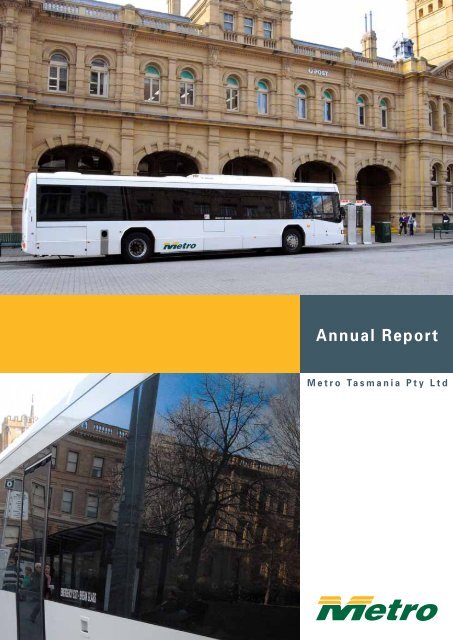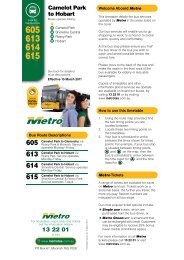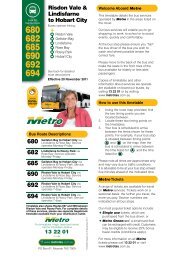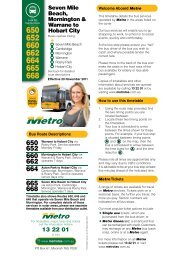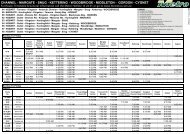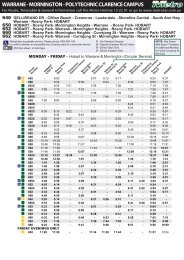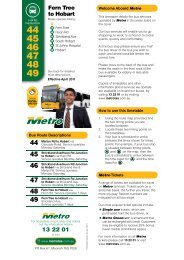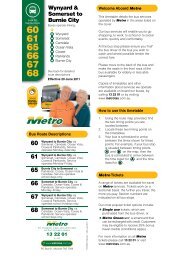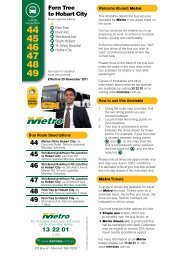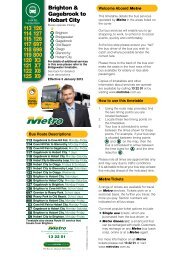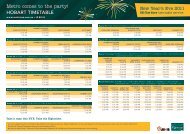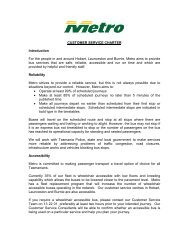Annual Report for 2006/07 - Metro Tasmania
Annual Report for 2006/07 - Metro Tasmania
Annual Report for 2006/07 - Metro Tasmania
- No tags were found...
You also want an ePaper? Increase the reach of your titles
YUMPU automatically turns print PDFs into web optimized ePapers that Google loves.
IntroductionThe Principal objective of <strong>Metro</strong> <strong>Tasmania</strong> Pty Ltd is defined in the <strong>Metro</strong> <strong>Tasmania</strong>Act, 1997. It is:“To provide, road passenger transport services in <strong>Tasmania</strong> and to operatethose services in a manner consistent with sound commercial practice.”This legislation was enacted in February 1998 and established <strong>Metro</strong> <strong>Tasmania</strong> PtyLtd as a State Owned Company operating under Corporations Law.<strong>Metro</strong> <strong>Tasmania</strong> Pty Ltd has evolved from the <strong>for</strong>mer <strong>Metro</strong>politan Transport Trust(MTT), which itself was <strong>for</strong>med in 1954 by the transfer of urban public transportservices operated by the Hobart and Launceston City Councils to the <strong>Tasmania</strong>nGovernment. In 1959, MTT extended its operations to include urban bus serviceswithin the Burnie Municipality.<strong>Metro</strong> provides a broad range of urban passenger transport bus services withinHobart, Launceston and Burnie, as well as between Wynyard, Burnie and Ulverstone.These services are specified within a Community Service Activity contract between<strong>Metro</strong> and the Department of Infrastructure, Energy and Resources (on behalf of theState Government). Full details of the general route services and special studentservices provided by <strong>Metro</strong> can be obtained by searching <strong>Metro</strong>’s website atwww.metrotas.com.au<strong>Metro</strong> also provides a range of local and statewide charter services, as well asspecial event and community services (such as <strong>for</strong> the Hobart Show).IntroductionTable of contentsCompany Directory 1Principal Offices 1Chairperson’s Review 2Chief ExecutiveOfficer’s Review 3Statistics andPer<strong>for</strong>mance Indicators 5Directors’ <strong>Report</strong> 8In its Corporate Plan <strong>Metro</strong> has identified its “vision” as achieving excellence inpassenger transport services and its “mission” as providing safe, reliable andquality road passenger transport services that balance stakeholder needs and soundcommercial practices.<strong>Metro</strong>’s Corporate Plan also sets out the Goals, Targets and Strategic Actionsthat <strong>Metro</strong> will be pursuing over the next 3 years in pursuit of its vision. <strong>Metro</strong>’sCorporate Plan can be downloaded from our website www.metrotas.com.au<strong>Metro</strong> now has a regional services division to operate services between Hobart andvarious regional centres. The services are delivered under individual route contractswith the Department of Infrastructure, Energy & Resources. They include services toBothwell, Kingston, Blackmans Bay, the Channel and New Norfolk.Until 30 June 2005 all these regional services, other than Hobart to Bothwell, weredelivered by <strong>Metro</strong>’s wholly owned subsidiary <strong>Metro</strong> Coaches (Tas) Pty Ltd underthe business name of Hobart Coaches. On 30 June 2005 the service contractsand business name were transferred to <strong>Metro</strong> as part of a corporate restructuringprogram.<strong>Metro</strong> is the registered trading name of <strong>Metro</strong> <strong>Tasmania</strong> Pty Ltd. Hobart Coaches isthe registered trading name <strong>for</strong> <strong>Metro</strong>’s regional services division.Auditor’sIndepence Declaration 9Directors’ Declaration 10Independent Audit <strong>Report</strong> 10Financial Statements 11
Company DirectoryNature of Business:Issued Capital:Registered Office:Provision of bus transport servicesTwo shares of $1.00 each212 – 220 Main RoadMoonah, <strong>Tasmania</strong>ABN Number: 30 081 467 281Directors:Sally Denny, ChairpersonShareholders:Senior Managers:Bankers:Auditor:Michael Wisby, Deputy ChairpersonKetrina ClarkeJanie FinlayRobert FlanaganCrown of <strong>Tasmania</strong>Tony Sim, Chief Executive OfficerJeff Dallas, Group ManagerOperations & EngineeringJack Lane, Manager Business DevelopmentAnita Robertson, Chief Financial Officer (part year)Navin Ram, Acting Chief Financial Officer (part year)Allison Ball, Manager Human ResourcesCommonwealth Bank of Australia81 Elizabeth StreetHobart, <strong>Tasmania</strong>Auditor GeneralPrincipal OfficesHobartAddress:Head Office212-220 Main Road, Moonah, TasPostal Address: PO Box 61, Moonah 7009Telephone: (03) 6233 4232Facsimile: (03) 6272 8770LauncestonAddress:168 Wellington Street, Launceston, TasPostal Address: PO Box 578, Launceston, 7250Telephone: (03) 6336 5888Facsimile: (03) 6336 5899BurnieAddress:28 Strahan Street, Burnie, TasPostal Address: PO Box 182, Burnie, 7320Telephone: (03) 6431 3822Facsimile: (03) 6431 9336Other contractsE-mail:Website:The <strong>Metro</strong> Shop:correspondence@metrotas.com.auwww.metrotas.com.auHobart GPOElizabeth Street Bus StationHobart, 7000
Chairperson’s ReviewChairperson’s ReviewIt is pleasing to report a profit be<strong>for</strong>e income tax of $3<strong>07</strong>,000 <strong>for</strong> the year.One of the main contributing factors to the result was a rigorousexpenditure management program in the face of increasing costs.<strong>Metro</strong> continues to examine ways it can be more efficient in the useof fuel in its existing fleet as a cost-saving initiative and as part of itsgreenhouse gas emissions reduction strategy.With this in mind <strong>Metro</strong> has undertaken a detailed assessment of theoption of Compressed Natural Gas (CNG), investigated the use of bio-fuels(bio-diesel and ethanol), and examined hybrid buses that use diesel orother fuels to power electric motors.While the use of CNG when compared to diesel is not viable <strong>for</strong> <strong>Metro</strong>,and reliability of supply <strong>for</strong> bio-fuels has been identified as an issue ofconcern, <strong>Metro</strong> will continue to monitor the commercial and operationalpotential of alternative fuels.In last year’s annual report I noted that negotiations <strong>for</strong> a new EnterpriseAgreement <strong>for</strong> bus operators had been resolved following a brief period ofindustrial action and that <strong>Metro</strong> was working with employees to rebuildgood working relationships.To assist in this process, an independent, external consultant wasappointed to undertake a comprehensive survey of employee opinionsand to identify issues of concern. Such issues have and continue to beaddressed in consultation with employee representatives.A major project over the last two years is the progressive review ofservices to ensure that they remain relevant to the needs of customers.<strong>Metro</strong> has limited resources and it is important to ensure that thoseresources are allocated as effectively as possible.In 2005/06 considerable time and ef<strong>for</strong>t was invested in reviewing busservices. In September <strong>2006</strong> <strong>Metro</strong>’s services <strong>for</strong> Burnie and the northwestcoast between Wynyard and Ulverstone were substantially modified.There were also significant changes made to Hobart services in November<strong>2006</strong>, primarily to overcome late-running problems.Following a comprehensive review of services on the north westcoast, with feedback and requests received from members of the localcommunity, councils and business representatives, <strong>Metro</strong> introducedSaturday bus services in Burnie and Wynyard and major improvements toweekday Burnie bus routes.The service changes were designed around the needs of shoppers, thoseundertaking recreational activities and students, and featured simpler busroutes on regular timetables.Following the introduction of these improved services, <strong>2006</strong>/<strong>07</strong> Burniepatronage figures show an increase of 3.5 per cent on the previousfinancial year. While the initial growth was small, passenger numbersincreased further as people became accustomed to the new services, inparticular Saturday services.In Hobart the service changes helped resolve a range of late runningproblems. These problems have been progressively emerging due inpart to deteriorating traffic conditions. <strong>Metro</strong> would like to see greateracceptance of the need to provide increased priority <strong>for</strong> public transport soas to make our urban areas work more effectively.A review of Launceston services commenced in <strong>2006</strong> and is expected tolead to major service changes being made prior to Christmas 20<strong>07</strong>.In undertaking the Launceston review, <strong>Metro</strong> has consulted withits customers and staff and shared its ideas with the community. Acomprehensive communication program is now planned to advise peopleof the outcome of the review process.In March the bus operator Tassielink acquired the operation of the <strong>Metro</strong>ownedHobart Coaches’ Hobart to Richmond – Campania – Colebrook busservice.This sale was a positive one <strong>for</strong> <strong>Metro</strong>. <strong>Metro</strong> benefited because it isable to better focus its resources on expanding services to the Kingstonand Channel markets while Tassielink can further develop its outer urbanbusiness.Importantly <strong>Metro</strong> and Tassielink worked closely together to ensure asmooth transition of services from one operator to the other, and that thetravelling public was not inconvenienced.Sadly I need to report that <strong>for</strong>mer <strong>Metro</strong> director Freddie Van Buren passedaway on 11 September <strong>2006</strong>. Freddie was a well respected member ofthe <strong>Metro</strong> Board who made a positive contribution to the business from1999 to 2003.In closing I would like to thank the management team, led by our CEO TonySim, and all our employees who work so diligently to deliver an effectiveand reliable passenger transport service to the <strong>Tasmania</strong>n communityand to acknowledge the hard work and strong support of my fellow boardmembers.Sally DennyChairperson
Chief Executive Officer’s ReviewAs I noted in last year’s <strong>Annual</strong> <strong>Report</strong>, increased patronage is thefundamental basis to underpin <strong>Metro</strong>’s future.Delivery of quality customer service and the provision of services thatare relevant to the needs of the community continue to be vital <strong>for</strong> ourorganisation.It is there<strong>for</strong>e very pleasing to report that in <strong>2006</strong>/<strong>07</strong> <strong>Metro</strong> carried9,945,000 people, just 55,000 short of the magic 10 million mark,and 340,000 more than during the previous financial year. It is alsoimportant to note that this is <strong>Metro</strong>’s best result since 1997/98.In percentage terms patronage increased by 0.5 per cent statewide,with adult patronage increasing by 0.6 per cent, adult concessionpatronage by 0.7 per cent and student patronage by 0.3 per cent.Looking ahead to the next financial year, patronage growth is expectedto continue at about the same rate.In January 20<strong>07</strong> <strong>Metro</strong> reluctantly increased the prices of some ticketsto cover cost increases since the last fare increase in January <strong>2006</strong>.Fares <strong>for</strong> Adult Concession, Child and Primary/Secondary Studentswere held at <strong>2006</strong> levels. Together, these groups comprise almost 75per cent of <strong>Metro</strong>’s business.Adult full fares were restructured as part of a long-term move toa simpler fare structure, as proposed by the Government PricesOversight Commission.Occupational Health and Safety continued to be a priority <strong>for</strong> <strong>Metro</strong> in<strong>2006</strong>/<strong>07</strong>.The Lost Time Injury Frequency Rate (lost time claims greater than oneshift multiplied by one million and divided by total number of hoursworked) was halved from 66 in 2005/06 to 33 this year.The annual severity rate of injuries (number of days lost multipliedby one million and divided by the total number of hours worked)dramatically fell from 696 last year to 150 in <strong>2006</strong>/<strong>07</strong>.Workers compensation claims this financial year also reducedfollowing the introduction of a new approach to injury management.<strong>Metro</strong> operates 215 buses in Hobart, Launceston and Burnie, of which42 are wheelchair accessible.In <strong>2006</strong>/<strong>07</strong> <strong>Metro</strong> commenced a contract <strong>for</strong> the supply of 20 DisabilityDiscrimination Act (DDA) compliant buses. Delivery of the first units isscheduled <strong>for</strong> early 2008 with 8 new buses expected to be deliveredand operating in service by June 2008. The remaining 12 buses are tobe supplied in the following financial year. The contract also allowsthe option <strong>for</strong> a further 20 buses to be built <strong>for</strong> <strong>Metro</strong>.The vehicles feature air conditioning, low emission Euro 4 & 5 dieselengines, Scania chassis, and bodies supplied by South Australianbasedcompany Custom Coaches Pty Ltd.In addition, there will be two further accessible buses delivered in20<strong>07</strong>/08 from historical orders, including <strong>Metro</strong>’s first long-wheelbase 14.5 metre bus with steerable rear tag axle to increase vehiclemaneuverability. If trials of this vehicle are successful it is likely thatfurther buses of this type will be used as replacements <strong>for</strong> <strong>Metro</strong>’sarticulated buses.In <strong>2006</strong>/<strong>07</strong> <strong>Metro</strong> became the first bus company in Australia to beaccredited to undertake its own vehicle inspections under the NationalHeavy Vehicle Accreditation Scheme.Programmed maintenance of vehicles is undertaken every 15,000kilometres but the intention is to extend that to 20,000 kilometres inthe short-term to improve bus availability and free up resources tofocus on predictive maintenance.During the year <strong>Metro</strong> announced that it was planning to introduce asingle new ticketing system to cover all of <strong>Metro</strong>’s operations.<strong>Metro</strong> currently operates three ticketing systems – one coveringHobart and Launceston, one in Burnie and one on Hobart Coaches.The proposed replacement system is a smartcard-based ticketingsystem, widely regarded as the most versatile and best availabletechnology.<strong>Metro</strong> has undertaken extensive research to ensure any new systemwill be reliable, flexible and user-friendly and has taken accountof comments from various stakeholders, including employees,passengers, suppliers, other operators and government, to developappropriate specification and tender documents.While the current ticketing systems are still operating well, in the caseof the Hobart and Launceston system, it is 20 years old and due <strong>for</strong>replacement.<strong>Metro</strong> introduced a number of changes to its Hobart timetables androutes in November <strong>2006</strong> following a comprehensive review of allservices and consultation with bus operators.The changes were designed to ensure <strong>Metro</strong> services continue to runon time following increases in traffic congestion.The new simplified routes on regular timetables through West Hobart,Mt Stuart and Lenah Valley not only achieved its goal but resulted inincreases in patronage on evening services and at weekends.At the same time, a simplified Busy Bee route was introduced toSandy Bay during evenings and weekends. The route was redesignedto ensure better access to the University Campus and Sandy Bayshops during off peak times.Last year I wrote that <strong>Metro</strong> was working to establish closer workingrelationships with local government that would ultimately develop abetter understanding of the needs of the communities in which <strong>Metro</strong>operates.In <strong>2006</strong>/<strong>07</strong> the Clarence City Council and <strong>Metro</strong> signed amemorandum of understanding (MOU) – the first of its kind in theState – to implement the joint Accessible Clarence Program.The program aims to provide the Clarence community with the bestpossible public transport services and facilities in a cost-effectivemanner.Following the signing of the memorandum with Clarence, <strong>Metro</strong>also signed an MOU with the Launceston City Council and discussedsimilar arrangements with the Brighton Council and the Burnie CityCouncil.<strong>Metro</strong> is continuing to work with local government organisationsstatewide to further enhance the effectiveness of its public transportservices to the community.<strong>Metro</strong> believes local government is the perfect partner to achievepositive outcomes given its strong relationship with the community itrepresents.Chief Executive Officer’s Review
Chief Executive Officer’s ReviewIn addition, <strong>Metro</strong> made application to the Commonwealth Attorney-General’s Department, in association with five <strong>Tasmania</strong>n councils (theBrighton Council and the Burnie, Clarence, Launceston and Hobart CityCouncils) and with the support of <strong>Tasmania</strong> Police, to seek fundingunder the National Community Crime Prevention Program (NCCPP) toimplement a community safety program on its buses and at bus mallsKnown as Project ECS (Enhanced Community Safety), it is designedto specifically address the fear of crime, anti-social behaviour andviolence towards senior citizens and children through the installationof additional lighting and closed circuit television (CCTV) infrastructurein strategically selected locations and on <strong>Metro</strong> buses.On the subject of security, <strong>Metro</strong>’s strong relationship with <strong>Tasmania</strong>Police continued in <strong>2006</strong>/<strong>07</strong> with four police officers working from<strong>Metro</strong> <strong>Tasmania</strong> premises at Derwent Park.Officers from the Public Order Response Teams also patrol <strong>Metro</strong> busservices in other parts of the State on a regular basis.The program, which has seen <strong>Tasmania</strong> Police officers essentiallytaking on the role of transit police on buses and at bus interchangeswithin the Hobart metropolitan area, has been very well received andis proving highly effective.Police officers attached to <strong>Metro</strong> undertake uni<strong>for</strong>m and plainclothes duties on all <strong>Metro</strong> services in the south of the state. Theirduties include random patrols on buses and in bus interchanges. Onoccasion’s patrols target identified problem areas.Details of a Code of Behaviour to improve safety on and around busesdeveloped <strong>for</strong> use in <strong>Tasmania</strong>n schools was announced during theyear by Minister <strong>for</strong> Infrastructure Jim Cox.The introduction of a <strong>for</strong>mal code followed <strong>Metro</strong>’s trial in sixLaunceston schools in term three of <strong>2006</strong>.The cornerstone of the trial was a code of behaviour <strong>for</strong> studentstravelling to and from school that clearly sets out what is and what isnot acceptable behaviour.The trial had a positive influence on the safety and com<strong>for</strong>t of travel toand from school <strong>for</strong> both students and drivers.The code model was developed through the Student Transport UserGroup of DIER. This group comprises representatives of the Parentsand Friends State Council, independent and catholic schools, the busindustry and the Departments of Education and Infrastructure, Energyand Resources.<strong>Metro</strong> manages a small portfolio of sponsorship agreements andpartners with a number of community-based organisations.Our sponsorship agreements are aligned to branding and profilebuildingopportunities within key client groups of bus users, and havea focus of encouraging long-term support and loyalty.<strong>Metro</strong> also sees itself as being a good corporate citizen andundertakes a range of activities that support worthwhile communityprojects and events.During <strong>2006</strong>/<strong>07</strong> <strong>Metro</strong> sponsored the following:• Football <strong>Tasmania</strong> (Tassie Mariners U16 and U18 representativeteams)• Neighbourhood Watch <strong>Tasmania</strong> Inc• Junior Netball• Point to Pinnacle run• Police Citizen and Youth Club Bridgewater• Hobart Christmas Pageant• CANTEEN• Road Safety Task Force• Southern Cross Special Children’s Christmas Party• Operation NOAH• Seniors’ Week• Holyoake• Diversity ‘We Are Who We Are’• Colony 47• Hobart Summer Festival<strong>Metro</strong> also contributes to the community by donating transportservices <strong>for</strong> a variety of causes.<strong>Metro</strong>, and <strong>Metro</strong> staff, actively work within the <strong>Tasmania</strong>ncommunity to support improved outcomes <strong>for</strong> those most in need.Tony SimChief Executive Officer
<strong>Metro</strong>’s student/child fare has been held fixed since 1996. As a consequence there has been a gradual decline in the proportion of child/studentpassengers using pre-paid tickets, with this figure falling from two-thirds to less than half over this period. This compares with the full fare Adultswhere there has been an increase from 32% to 39% over the same period.Table 3 – Trends in Prepaid Ticket Use as a % of First Boardings For Different Passenger Categories.Adult Full Fare Adult Concession Child/Student Total All Categories% % % %1997/98 32.3 22.9 66.3(ii) 50.9(i)1998/99 31.9 22.1 62.8(ii) 49.9(i)1999/00 32.0 20.7 63.0(ii) 48.6(i)2000/01 33.3 20.2 62.2(ii) 47.7(i)2001/02 33.3 20.2 60.7(ii) 46.4(i)2002/03 34.0 20.0 59.5(ii) 46.2(i)2003/04 34.5 20.3 58.2(ii) 46.6(i)2004/05 34.3 22.4 55.2(ii) 46.8(i)2004/05 (iii) 35.3 22.4 53.2(ii) 46.2(i)2005/06 (iii) 36.4 22.6 50.2(ii) 45.8(i)<strong>2006</strong>/<strong>07</strong> (iii) 38.8 23.1 48.0(ii) 45.6(i)(i) Total All Categories - free trips made by eligible school children are included as “pre-paids”.(ii) Child/Student statistics exclude free school trips.(iii) Includes patronage associated with Kingston and Blackmans Bay services. Prior to 2004/05 patronage to Kingston and Blackmans Bayhas been excluded.<strong>Metro</strong> Fleet And Work<strong>for</strong>ce<strong>Metro</strong> now has accessible buses in all centres. Table 4 shows the proportion of the fleet that is accessible, as well as the proportionof general route services that are delivered by accessible buses in each centre.Table 4 – Percentage Of <strong>Metro</strong>(i) General Route Services Delivered By Accessible Buses(as at 30 June 20<strong>07</strong>Hobart Launceston Burnie State% Fleet Accessible 22.1% 12.0% 21.4% 19.7%% Weekly Trips(ii) 30.5% 15.0% 42.0% 27.9%(i) Includes services <strong>for</strong> Kingston and Blackmans Bay, and the combined <strong>Metro</strong> plus Hobart Coaches fleets.(ii) This is the percentage of services operated with an accessible bus, not the percentage advertised as accessible. The percentage may fall on agiven day if a number of accessible buses are not available <strong>for</strong> some reason.Statistics and Per<strong>for</strong>mance Indicators
Table 5 – Number of Buses in Service (As at 30 June 20<strong>07</strong>)Hobart Coaches<strong>Metro</strong> FleetFleet Hobart Launceston Burnie TotalM.A.N. 1 11 7 2 21Scania 4 81 37 9 131Scania Low Floor (12.5m) - 30 6 3 39Scania Low Floor (14.5m) - 3 - - 3Volvo Articulated - 19 - - 19Totals 5 144 50 14 213Special Bus Features :-Accessible Buses - 33 6 3 42Video Surveillance 3 46 9 3 61Air Conditioned 3 18 - - 21Table 6 – <strong>Metro</strong> Work<strong>for</strong>ce And Fleet Utilisation Statistics2005/06 <strong>2006</strong>/<strong>07</strong>Average FTE’s per vehicle 1.78 1.80Sick leave days per full time equivalent employee 9.14 7.30Number of workers’ compensation lost time injury claims 40 26Number of employees at 30 June <strong>07</strong> 441 454Average full-time equivalent employees <strong>for</strong> year 380.35 388Number of employees entering service 63 51Number of employees leaving service 43 47Web Site<strong>Metro</strong> provides access to a wide range of in<strong>for</strong>mation through its web site; www.metrotas.com.au. The site provides a comprehensive source ofin<strong>for</strong>mation on <strong>Metro</strong> and its services. In<strong>for</strong>mation on Hobart Coaches services can be obtained either through the links from the <strong>Metro</strong> web site orthrough Hobart Coaches own web site www.hobartcoaches.com.au. Visits to the <strong>Metro</strong> website during a typical month average 23,000 +.Public Interest Disclosures<strong>Metro</strong> is required to establish procedures <strong>for</strong> the disclosure and investigation of improper conduct or detrimental action. These procedures have beenmade accessible via <strong>Metro</strong>’s web site. No disclosures were made to or about <strong>Metro</strong> during the financial year.Statistics and Per<strong>for</strong>mance Indicators
Directors’ <strong>Report</strong>Directors’ <strong>Report</strong>The Directors of <strong>Metro</strong> <strong>Tasmania</strong> Pty Ltd present the annual financialreport <strong>for</strong> the year ended 30 June 20<strong>07</strong>.Principal activities<strong>Metro</strong>’s principal activity during the financial year was the provision of buspassenger transport services in the <strong>Tasmania</strong>n urban centres of Hobart,Launceston and Burnie and to some regional centres around Hobart.Review of operationsFor the year ended 30 June 20<strong>07</strong> <strong>Metro</strong> recorded a profit be<strong>for</strong>e incometax of $3<strong>07</strong>,000 (<strong>2006</strong>:$30,000) and a profit after tax of $ 184,000 (<strong>2006</strong>:loss of $16,000).A detailed review of operations is contained in the Chairperson’s Reviewand in the Chief Executive Officer’s Review.DividendsThe directors do not recommend payment of a dividend from the profit <strong>for</strong>this year. No dividend was paid from the profit recorded in the year ended30 June <strong>2006</strong>.Changes in state of affairsThere were no significant changes in the state of affairs of the companythat occurred during the financial year under review.Superannuation DeclarationThe company has met its obligations under the Superannuation Guarantee(Administration) Act 1992 in respect to those employees who are membersof a complying superannuation scheme to which <strong>Metro</strong> contributes. Thecompany also has a defined benefit scheme, under the Retirement BenefitsAct 1993, which is subject to actuarial valuations and covers current and<strong>for</strong>mer employees.Subsequent eventsThere has not been any matter or circumstance other than that referred toin the financial statements or notes thereto, that has arisen since the endof the financial year, that has significantly affected, or may significantlyaffect, the operation of the entity, the results of those operations, or thestate of affairs of the entity in future financial years.Likely future developments<strong>Metro</strong> will continue to pursue with its mission of providing safe, reliableand quality road passenger transport services that balance stakeholderneeds and sound commercial practices. This will require further capitalexpenditures on new buses, route infrastructure, fare collection systemsand support facilities. In addition, <strong>Metro</strong> will maintain a watching brief onalternative fuels.Rounding off of amounts<strong>Metro</strong> is a company of the kind referred to in ASIC Class Order 98/0100dated 10 July 1998 and in accordance with that Class Order amounts inthe Directors’ report and the financial report have been rounded off to thenearest thousand dollars.DirectorsNames of directors in office during and since the end of the financial yearare set out in Note 21 of the financial statements. Directors are appointed<strong>for</strong> rolling terms of three years. The Chairperson is appointed annually bythe shareholders.Corporate GovernanceThe board of directors is responsible <strong>for</strong> the overall corporate governanceof the company. Corporate governance is the system by which theactivities of a company are controlled and coordinated in order <strong>for</strong> thecompany to achieve its desired outcomes.As a state owned company the Board is responsible to its shareholders,the Minister <strong>for</strong> Infrastructure, Energy and Resources and the Treasurerin meeting the aspirations of the state government and the board directsmanagement accordingly.The Board per<strong>for</strong>ms this role by:• Appointing and monitoring the per<strong>for</strong>mance of the ChiefExecutive Officer;• Clearly identifying and enunciating the strategic direction <strong>for</strong> <strong>Metro</strong>;• Identifying and addressing the principal risks <strong>for</strong> <strong>Metro</strong>;• Monitoring the conduct and per<strong>for</strong>mance of the company through anintegrated framework of controls;• Ensuring all <strong>Metro</strong>’s business is conducted in an honest, open andethical manner; and• Ensuring adequate succession planning is undertakenDirectors’ remunerationFees paid to directors are set by the Minister representing the Crown.Details are set out in Note 21 of the financial statements.During the twelve months, no director has received, or become entitled toreceive, a benefit by reason of a contract made by <strong>Metro</strong> with a director orwith a firm of which he or she is a member or an entity in which he or shehas a financial interest.Remuneration CommitteeThe Remuneration Committee comprises two non-executive directors andthe CEO. This committee oversees remuneration practices and policies inrelation to senior executives of the company.Audit and risk management Committee<strong>Metro</strong> has an audit committee, which comprises three directors and ischaired by the Deputy Chairperson of the board. The audit committeehas a documented charter, approved by the board. The committee’sresponsibilities under its charter include consideration and monitoringof matters relating to external reporting, risk management, internal andexternal audit functions. The Company Secretary and Chief FinancialOfficer also attend meetings.
Auditor’s independence declarationThe accounts of the company are independently audited by the <strong>Tasmania</strong>n Auditor General. The Auditor General has provided the Directors withIndependence Declaration as required under section 3<strong>07</strong>C of the Corporations Act 2001.Indemnification of Directors and OfficersDuring the financial year <strong>Metro</strong> paid a premium in respect of a contract insuring the directors of <strong>Metro</strong>, all executive officers of <strong>Metro</strong> and its related bodycorporate against potential liabilities to the extent permitted by Corporations Law.Signed in accordance with the resolutions of the Directors made pursuant to Section 298 (2) of the Corporations Act 2001 on behalf of the Directors.Sally DennyChairpersonDated at Hobart this 10th day of September 20<strong>07</strong>.Auditor’s Independence Declaration
10Directors’ DeclarationIn the opinion of the Directors of <strong>Metro</strong> <strong>Tasmania</strong> Propriety Limited (the ‘Company’):(a) the financial statements and the notes are in accordance with the Corporations Act 2001, including:(i) giving a true and fair view of the financial position of the Company as at 30 June 20<strong>07</strong> and its per<strong>for</strong>mance, as represented by theresults of its operations and its cash flows <strong>for</strong> the year ended on that date; and(ii) complying with Australian equivalents to International Financial <strong>Report</strong>ing Standards and the Corporations Regulations 2001; and(b) there is reasonable grounds to believe that the company will be able to pay its debts as and when they become due and payable.Signed in accordance with a resolution of the directors made pursuant to s.295(5) of the Corporations Act 2001.On behalf of the DirectorsSally DennyChairperson of theBoard of DirectorsMichael WisbyMember of theBoard of DirectorsDated at Hobart this 10th day of September 20<strong>07</strong>.Directors’ Declaration
Balance SheetAs at 30 June 200ConsolidatedCompanyNote 20<strong>07</strong> <strong>2006</strong> 20<strong>07</strong> <strong>2006</strong>$’000 $’000 $’000 $’000Current AssetsCash and cash equivalents 7 13,446 11,246 13,446 11,246Trade and other receivables 8 609 635 609 635Inventories 9 849 853 849 853Assets held <strong>for</strong> sale 10 67 242 67 242Other current assets 11 564 571 564 571Total Current Assets 15,535 13,547 15,535 13,547Non-Current AssetsProperty, plant and equipment 12 36,889 33,<strong>07</strong>6 36,889 33,<strong>07</strong>6Intangible assets 13 367 166 367 166Deferred tax assets 6 10,038 9,777 10,038 9,777Total Non-Current Assets 47,294 43,019 47,294 43,019TOTAL ASSETS 62,829 56,566 62,829 56,566Current LiabilitiesTrade and other payables 14 2,621 3,187 2,728 3,294Borrowings 15 2,792 - 2,792 -Employee benefits 16 8,178 6,614 8,178 6,614Total Current Liabilities 13,591 9,801 13,698 9,908Non-Current LiabilitiesBorrowings 15 - 2,792 - 2,792Employee benefits 16 14,454 13,479 14,454 13,479Deferred tax liabilities 6 5,269 3,809 5,269 3,809Total Non-Current Liabilities 19,723 20,080 19,723 20,080TOTAL LIABILITIES 33,314 29,881 33,421 29,988NET ASSETS 29,515 26,685 29,408 26,578EquityContributed equity 17 15,503 15,503 15,503 15,503Asset revaluation reserve 18 10,317 6,785 10,317 6,785Retained profits 19 3,695 4,397 3,588 4,290TOTAL EQUITY 29,515 26,685 29,408 26,578The Balance Sheet is to be read in conjunction with the Notes to the Financial Statements.Financial Statements11
12Income StatementFor the year ended 30 June 200ConsolidatedCompanyNote 20<strong>07</strong> <strong>2006</strong> 20<strong>07</strong> <strong>2006</strong>$’000 $’000 $’000 $’000RevenueTraffic operations revenue 4(a) 36,550 34,620 36,550 34,620Other operating income 4(b) 758 619 758 619Financial income 4(c) 890 660 890 66038,198 35,899 38,198 35,899ExpensesTraffic operations 5(a) (28,199) (27,011) (28,199) (27,011)Engineering and maintenance services 5(b) (4,841) (4,772) (4,841) (4,772)Administration and general 5(c) (4,676) (3,913) (4,676) (3,913)Financial expense 5(d) (175) (173) (175) (173)(37,891) (35,869) (37,891) (35,869)Profit be<strong>for</strong>e income tax 3<strong>07</strong> 30 3<strong>07</strong> 30Income tax expense 6 (123) (46) (123) (46)Profit / (loss) <strong>for</strong> the year 184 (16) 184 (16)The Income Statement is to be read in conjunction with the Notes to the Financial Statements.Statement of Recognised Income and ExpensesFor the year ended 30 June 20<strong>07</strong>ConsolidatedCompanyNote 20<strong>07</strong> <strong>2006</strong> 20<strong>07</strong> <strong>2006</strong>$’000 $’000 $’000 $’000Actuarial gains / (losses) ondefined benefits plan 26 (1,363) 1,824 (1,363) 1,824Income tax on income and expenserecognised directly in equity 19 (409) 610 (409) 610Financial StatementsIncome and expenserecognised directly in equity (1,772) 2,434 (1,772) 2,434Profit / (loss) <strong>for</strong> the year 184 (16) 184 (16)Total recognised incomeand expense <strong>for</strong> the year (1,588) 2,418 (1,588) 2,418The Statement of Recognised Income and Expenses is to be read in conjunction with the Notes to the Financial Statements.
Cash Flow StatementFor the year ended 30 June 200ConsolidatedCompanyNote 20<strong>07</strong> <strong>2006</strong> 20<strong>07</strong> <strong>2006</strong>$’000 $’000 $’000 $’000Cash flows from operating activitiesCash receipts from customers 38,687 37,355 38,687 37,355Interest received 4 890 660 890 660Cash paid to suppliers and employees (35,280) (34,644) (35,280) (34,644)Interest paid (175) (173) (175) (173)Net cash provided by operating activities 23(a) 4,122 3,198 4,122 3,198Cash flows from investing activitiesProceeds from sale of property,plant and equipment 740 423 740 423Acquisition of property, plant and equipment (2,662) (4,024) (2,662) (4,024)Net Cash flows used in investing activities (1,922) (3,601) (1,922) (3,601)Cash flows from financing activitiesRepayment of treasury borrowings - (35) - (35)Net Cash used in financing activities - (35) - (35)Net increase in cash and cash equivalents 2,200 (438) 2,200 (438)Cash and cash equivalents atthe beginning of the financial year 11,246 11,684 11,246 11,684Cash and cash equivalentsat the end of the financial year 23(b), 7 13,446 11,246 13,446 11,246The Cash Flow Statement is to be read in conjunction with the Notes to the Financial Statements.Financial Statements13
14Notes to the Financial StatementsFor the year ended 30 June 20<strong>07</strong>1. <strong>Report</strong>ing Entity<strong>Metro</strong> <strong>Tasmania</strong> Pty Ltd (the ‘Company’) is a <strong>Tasmania</strong>n State Owed Company domiciled in Australia. The address of the company’sregistered office is 212 – 220 Main Road, Moonah, <strong>Tasmania</strong>. The consolidated financial statements as at and <strong>for</strong> the year ended 30June 20<strong>07</strong> comprise the Company and its subsidiary (together referred to as ‘<strong>Metro</strong>’).2. Basis Of Preparation(a) Statement of complianceThe financial report is a general purpose financial report which has been prepared in accordance with Australian AccountingStandards (AASBs) (including Australian Interpretations) adopted by the Australian Accounting Standards Board (AASB) and theCorporations Act 2001. The consolidated and Company financial reports comply with the IFRSs and interpretations adopted by theInternational Accounting Standards Board.The financial statements were authorised <strong>for</strong> issue by the directors on 10 September 20<strong>07</strong>.Notes to the Financial StatementsNew standards and interpretations not yet adoptedThe following standards and amendments were available <strong>for</strong> early adoption at the date of authorisation of the financial report buthave not been applied by the consolidated entity in these financial statements:• AASB 7 Financial instruments: Disclosure (August 2005) and consequential amendments to other accounting standards from itsissue, replacing the presentation requirements of financial instruments in AASB 132. AASB 7 is applicable <strong>for</strong> annual reportingperiods beginning on or after 1 January 20<strong>07</strong>.• AASB 8 Operating Segments (February 20<strong>07</strong>) and consequential amendments to other accounting standards from its issue,replacing AASB 114 <strong>for</strong> entities whose debt or equity instruments are traded in a public market. AASB 8 is applicable <strong>for</strong> annualreporting periods beginning on or after 1 January 2009.• AASB 101 Presentation of Financial Statements (October <strong>2006</strong>) revised standard. AASB 101 is applicable <strong>for</strong> annual reportingperiods beginning on or after 1 January 20<strong>07</strong>.• AASB <strong>2006</strong>-1 Amendments to Accounting Standards AASB 121 (January 06) is applicable <strong>for</strong> annual reporting periods beginningon or after 31 December <strong>2006</strong>.• AASB <strong>2006</strong>-3 Amendments to Accounting Standards AASB 1045 (October 06) is applicable <strong>for</strong> annual reporting periodsbeginning on or after 31 December <strong>2006</strong>.• AASB <strong>2006</strong>-4 Amendments to Accounting Standards AASB 134 (December 06) is applicable <strong>for</strong> annual reporting periodsbeginning on or after 31 December <strong>2006</strong>.• Interpretation 11 (AASB 20<strong>07</strong>-1) is applicable <strong>for</strong> annual reporting periods beginning on or after 1 March 20<strong>07</strong>.• Interpretation 12 (AASB 20<strong>07</strong>-2) is applicable <strong>for</strong> annual reporting periods beginning on or after 1 January 2008.The directors anticipate that the adoption of these Standards and Interpretations in future periods will have no material financialimpact on the financial statements of the company or consolidated entity. These Standards and Interpretations will be first appliedin the financial report of the consolidated entity that relates to the annual reporting period beginning after the effective date of eachpronouncement.(b) Basis of measurementThe financial report has been prepared on an accrual basis and is based on historical costs and does not take into account changingmoney values except <strong>for</strong> land, buildings and buses which are measured at fair value. The accounting policies have been consistentlyapplied, unless otherwise stated.(c) Functional and presentation currencyThese consolidated financial statements are presented in Australian dollars, which is the Company’s functional currency and allvalues are rounded to the nearest thousand dollars ($000) unless otherwise stated under the option available under ASIC ClassOrder 98/100.(d) Use of estimates and judgementsThe preparation of financial statements requires management to make judgements, estimates and assumptions that effect theapplication of accounting. Actual results may differ from these estimates.Estimates and underlying assumptions are reviewed on an ongoing basis. Revisions to accounting estimates are recognised in theperiod in which the estimate is revised and in any future periods affected.
3. Significant Accounting Policies(a) Basis of consolidationThe consolidated financial statements have been prepared by combining the financial statements of all the entities that comprise theeconomic entity, being <strong>Metro</strong> <strong>Tasmania</strong> Pty Ltd (the parent entity) and its controlled entity <strong>Metro</strong> Coaches (Tas) Pty Ltd. Refer to Note25. Consistent accounting policies have been employed in the preparation and presentation of the consolidated financial statements.In preparing the consolidated financial statements, all inter- company transactions, balances, income and expenses are eliminated in full.(b) Goods and Services Tax (GST)Revenue, expenses and assets are recognised net of the amount of GST, except <strong>for</strong> receivables and payables that are recognisedinclusive of GST.The net amount of GST recoverable from, or payable to, the Australian Taxation Office (ATO) is included as a current asset or liability inthe Balance Sheet.Cash flows are included in the Cash Flow Statement on a gross basis. The GST components of cash flows arising from investing andfinancing activities, which are recoverable from the ATO, are classified as operating cash flows.Commitments and contingencies are disclosed net of the amount of GST recoverable from, or payable to the ATO.(c) RevenueTraffic operations revenueTraffic operation revenue is recognised at the time the service is provided.InterestInterest is recognised as it accrues.Sale of non- current assetsThe net gain (loss) of non current asset sales are included as income (expenses) at the date the date control passes to the buyer, usuallywhen an unconditional contract of sale is signed.The net gain or loss on disposal is calculated as the difference between the carrying amount of the asset at the time of disposal and thenet proceeds on disposal.Assets which satisfy the criteria in AASB 5 ‘ Non- Current Assets Held <strong>for</strong> Sale’ are transferred to current assets and separatelydisclosed as assets held <strong>for</strong> sale on the face of the Balance Sheet. These assets are measured at the lower of carrying amount and fairvalue less costs to sell. These assets cease to be depreciated from the date which they satisfy the held <strong>for</strong> sale criteria.(d) Cash and cash equivalentsCash and cash equivalents comprise cash on hand, cash at banks and call deposits.(e) ReceivablesTrade receivables and other receivables are recorded at nominal amounts due less any provision <strong>for</strong> doubtful debts and are recognisedon delivery of services to customers. A significant volume of <strong>Metro</strong>’s operations are per<strong>for</strong>med <strong>for</strong> the State Government or are receivedas cash fares. Accordingly, exposure to credit risk is minimal. An estimate <strong>for</strong> doubtful debts is made when collection of the full amountis no longer probable. Bad debts are written off when identified.(f) PayablesTrade and other payables represent liabilities <strong>for</strong> goods and services provided to <strong>Metro</strong> prior to the end of the financial year which areunpaid. Measurement is based on the agreed purchase/ contract cost. The amounts are unsecured and are usually paid within 30 daysof recognition.Notes to the Financial Statements15
16(g) BorrowingsLoans are recorded at an amount equal to the net proceeds received. Interest expense is recognised on an accruals basis.(h) InventoriesInventories are valued at the lower of cost or current replacement cost which consists of bus spare parts, fuel and consumablestores.(i) Property, plant and equipmentItems of property, plant and equipment are measured at cost less accumulated depreciation and impairment loss with the exceptionof land, buildings and the bus fleet which are independently valued at fair value.DepreciationDepreciation is recognised in profit or loss on a straight line basis over the estimated useful lives of each part of an item of property,plant and equipment (excluding freehold land and the bus fleet) as follows:BuildingsRoute infrastructureOther plant and equipmentElectronic ticketingIn<strong>for</strong>mation technology equipmentAuxiliary vehicles40 years10 years10 years10 years4 years4 yearsThe bus fleet is depreciated using the ‘Adjusted Industry Rule of Thumb’.(j) Impairment of assetsThe carrying values of tangible and intangible assets are reviewed <strong>for</strong> impairment when events or changes in circumstancesindicate that the carrying value may exceed the recoverable amount. The asset is then written down to the recoverable amount.Recoverable amount is the greater of fair value less costs to sell and value in use.(k) Intangible assetsIntangible assets are valued at fair value where an active market exists or valued at cost where no active market exists.Amortisation is recognised in profit or loss on a straight-line basis over the estimated useful lives of intangible assets, other thangoodwill, from the date that they are available <strong>for</strong> use as follows:LicencesComputer software4 years4 yearsNotes to the Financial Statements(l) Leased assetsLease payments <strong>for</strong> the operating leases on property where substantially all the risks and benefits remain with the lessor, arecharged as expenses in the periods in which they are incurred.(m) Employee benefitsEmployee benefits expected to be settled within one year have been measured at the amounts expected to be paid. Employeebenefits payable later than one year have been measured at the present value of the estimated future cash outflows to be made<strong>for</strong> those benefits. Discount rates used reflects national government securities that most closely match the terms of maturity of therelated liabilities.Compensated benefits<strong>Annual</strong> leaveThe provision <strong>for</strong> annual leave represents the amount <strong>Metro</strong> has a present obligation to pay resulting from employees’ servicesprovided up to balance date. The provision has been calculated at the amounts expected to be paid when the liability is settled andincludes superannuation on-costs.Long service leaveThe liability of employee benefits <strong>for</strong> long service leave represents the present value of the estimated future cash outflow to bemade by the employer resulting from employees’ services provided up to balance date. In determining the liability <strong>for</strong> employeebenefits, account has been taken of future increases in wage and salary rates, and <strong>Metro</strong>’s experience with staff departures.Related superannuation on-costs also have been included in the liability.
Retirement benefitsDefined benefit superannuation planPricewaterhouseCoopers has provided actuarial calculations of the current benefit of the defined benefit liability under the RetirementBenefits Fund (RBF) <strong>for</strong> current and <strong>for</strong>mer employees of <strong>Metro</strong>.The RBF is a defined benefit fund which pays lump sum and pension benefits to members upon retirement (most of which arecalculated as a multiple of the member’s final average salary). The RBF has Contributory members, Compulsory preserved membersand Pensioners.Actuarial gains and losses are recognised in full, directly in retained earnings, in the period in which they occur, and presented in thestatement of changes in equity. Details are referred to at Note 26.(n) ProvisionsA provision is recognised when there is a present, legal or constructive obligation as a result of a past event and it is probable that anoutflow of economic benefits will be required to settle the obligation, the timing or amount of which is uncertain.DividendsDividends payable are recognised in the reporting period in which they are declared, <strong>for</strong> the entire undistributed amount, regardlessof the extent to which they will be paid in cash. No dividend was recommended by the Board prior to the end of the current financialyear.(o) Income taxIncome tax expense comprises current and deferred tax. Income tax expense is recognised in profit or loss except to the extent that itrelates to items recognised directly in equity, in which case it is recognised in equity.Current tax is the expected tax payable on the taxable income <strong>for</strong> the year, using tax rates enacted or substantively enacted at thereporting date, and any adjustments to tax payable in respect of previous years.Deferred tax is recognised using the balance sheet method, providing <strong>for</strong> temporary differences between the carrying amounts ofassets and liabilities <strong>for</strong> financial reporting purposes and the amounts used <strong>for</strong> taxation purposes. Deferred tax is not recognised <strong>for</strong> thefollowing temporary differences; initial recognition of goodwill, the initial recognition of assets and liabilities in a transaction that is not abusiness combination and that affects neither accounting nor taxable profit, and differences relating to investments in subsidiaries andjointly controlled entities to the extent that they probably will not reverse in the <strong>for</strong>eseeable future. Deferred tax is measured at the taxrates that are expected to be applied to the temporary differences when they reverse, based on the laws that have been enacted orsubstantively enacted by the reporting date.A deferred tax asset is recognised to the extent that it is probable that future taxable profits will be available which temporarydifference can be utilised. Deferred tax assets are reviewed at each reporting date and reduced to the extent that it is not longerprobable that the related tax benefit will be realised.<strong>Metro</strong> has prepared full disclosure in accordance with AASB 112 ‘Income Taxes’ this financial year following its requirement as areporting entity to comply with the standard.(p) Tax consolidationThe Company and its wholly owned Australian resident entity have <strong>for</strong>med a tax consolidated group with effect from 1 July 2004 andare there<strong>for</strong>e taxed as a single entity from that date. The head entity within the tax-consolidated group is <strong>Metro</strong> <strong>Tasmania</strong> Pty Ltd andthe subsidiary entity is <strong>Metro</strong> Coaches (TAS) Pty Ltd.(q) Segment reporting<strong>Metro</strong> operates bus services in Hobart, Launceston and Burnie. There are no reportable segments as the economic risks and returns ineach location are similar given the Community Service Agreement with Government.(r) Comparative amountsCertain comparatives have been reclassified or adjusted to reflect any changes in accounting policy or the adoption of new standardsand to ensure consistent presentation with the current year. Details of the changes in comparative figures are referred to at Note 16and 23.Notes to the Financial Statements17
18(s) Prior period correctionRecognition of deferred tax balancesCorrection of prior period errors are reported in accordance with Accounting Standard AASB 108 – Accounting Policies, Changesin Accounting Estimates and Errors. In accordance with this standard, correction of prior period amounts shall be undertakenretrospectively in the first financial report authorised <strong>for</strong> issue after their discovery.The Company is required to recognise the measurement and disclosure of amounts of elements of financial statements as if a priorperiod error had never occurred.Nature of prior period correctionAs at 30 June 2005, the Company did not recognise any deferred tax assets and deferred tax liabilities as required by AccountingStandard AASB 112 Income Taxes on the basis that the company was a “not <strong>for</strong> profit” entity and as a consequence its intentionwas not to generate profits that would be subject to tax . <strong>Metro</strong>’s contract with the <strong>Tasmania</strong>n Government is based on a“breakeven” financial outcome each year.On reconsidering AASB 112 and the reasons <strong>for</strong> not recognising deferred tax balances previously, the directors now believe thatthe company should have recognised deferred tax assets and deferred tax liabilities. AASB 112 is a sector-neutral standard, andon this basis it applies to both <strong>for</strong>-profit and not-<strong>for</strong>-profit entities. In addition, AASB 112 stipulates that the consideration of currentand future tax consequences of assets and liabilities should be based on the taxable profits (losses) of the entity. The company’sassessment of these factors in the prior year’s was focussed on accounting profit (losses). Further, on transition to A-IFRS on 1 July2004, the test <strong>for</strong> recognising deferred tax balances changed from “virtually certain” to “probable” which is a less stringent test. Areview and reconsideration of in<strong>for</strong>mation and facts that were available on transition has indicated that there was sufficient evidenceto indicate that the company should have recognised its deferred tax balances.In accordance with AASB 108 – Accounting Policies, Changes in Accounting Estimates and Errors, the company elected to correctthe oversight as at the date of transition to A-IFRS, being 1 July 2004, by restating the opening balances of assets, liabilities andequity <strong>for</strong> the 30 June <strong>2006</strong> financial year.The effects are:1 July 2004The recognition of tax balances by including deferred tax assets of $9,571,000 and deferred tax liabilities of $4,175,000. This alsoresulted in an increase in retained profits of $6,576,000 and a decrease in the asset revaluation reserve of $1,180,000.30 June 2005The recognition of the movement in deferred tax balances with an increase to deferred tax assets of $1,148,000, a decrease tothe deferred tax liabilities of $249,000, an increase to the asset revaluation reserve of $99,000, an increase in retained profit of$1,298,000, an increase to income tax expense recognised in the income statement of $211,000 and an increase to income taxbenefit recognised in equity of $635,000.Notes to the Financial Statements30 June <strong>2006</strong>The recognition of the movement in deferred tax balances with a decrease to deferred tax assets of $943,000, a decrease tothe deferred tax liabilities of $118,000, an decrease to the asset revaluation reserve of $215,000, a decrease in retained profitof $610,000, an increase to income tax expense recognised in the income statement of $46,000 and an increase to income taxexpense recognised in equity of $547,000.
4. Revenue(a) Revenue from traffic operationsConsolidatedCompany20<strong>07</strong> <strong>2006</strong> 20<strong>07</strong> <strong>2006</strong>$000’s $000’s $000’s $000’sService contracts 26,6<strong>07</strong> 25,130 26,6<strong>07</strong> 25,130Ticket fares 9,943 9,490 9,943 9,490(b) Revenue from other operating income36,550 34,620 36,550 34,620Profit on disposal of property, plant and equipment 181 58 181 58Advertising income 309 322 309 322Rental income 48 50 48 50Other income 220 189 220 189(c) Financial income758 619 758 619Interest income 890 660 890 660890 660 890 660Total income 38,198 35,899 38,198 35,8995. Expenses(a) Expenses from traffic operationsConsolidatedCompany20<strong>07</strong> <strong>2006</strong> 20<strong>07</strong> <strong>2006</strong>$000’s $000’s $000’s $000’sFuel 4,225 4,133 4,225 4,133Employee and related expense 19,532 17,901 19,532 17,90Depreciation and amortisation expenses 2,614 2,640 2,614 2,640Other expenses 1,828 2,337 1,828 2,337(b) Expenses from engineering and maintenance services28,199 27,011 28,199 27,011Maintenance expense 2,826 2,630 2,826 2,630Employee and related expense 1,875 1,967 1,875 1,967Depreciation and amortisation expenses 63 48 63 48Other expenses 77 127 77 127(c) Expenses from administration and general4,841 4,772 4,841 4,772Employee and related expense 2,160 1,818 2,160 1,818Depreciation and amortisation expenses 373 343 373 343Other expenses 2,143 1,752 2,143 1,752(d) Financial expenses4,676 3,913 4,676 3,913Interest expense 175 173 175 173175 173 175 173Total expenses 37,891 35,869 37,891 35,869Notes to the Financial Statements19
206. Income Tax(a) Income tax expense recognisedin the Income StatementThe components of tax expense comprise:ConsolidatedCompany20<strong>07</strong> <strong>2006</strong> 20<strong>07</strong> <strong>2006</strong>$000’s $000’s $000’s $000’sCurrent tax 98 46 98 46Deferred tax 5 - 5 -Net gain on assets transferred from equity 20 - 20 -Income tax expense 123 46 123 46(b) Numerical reconciliation of income taxexpense to prima facie tax payablePrima facie tax/(tax benefit) on profit/(loss) fromoperating activities be<strong>for</strong>e incometax at 30% (<strong>2006</strong>: 30%) 92 9 92 9Add tax effect of:Gain on assets transferred from equity 20 31 20 31Amortisation of intangibles 5 5 5 5Entertainment (non-deductible) 1 1 1 1Under provision of prior year income tax 5 - 5 -123 46 123 46(c) Income tax expense recogniseddirectly to equityRevaluation of property, plant and equipment 1,505 232 1,505 232Decrease in superannuation reserve (409) 547 (409) 5471,096 779 1,096 779(d) Current and deferred tax balancesAssets:Deferred tax assets 10,038 9,777 10,038 9,77710,038 9,777 10,038 9,777Notes to the Financial StatementsLiabilities:Deferred tax liability 5,269 3,809 5,269 3,8094,769 5,968 4,769 5,968
20<strong>07</strong> ConsolidatedCategory Opening Recognised inbalance Income Recognised Balance at1 Jul 06 Prior year Statement in equity 30 Jun 20<strong>07</strong>$’000 $’000 $’000 $’000 $’000Superannuation 4,890 (58) 229 409 5,470Losses 3,571 53 (481) - 3,143Employee entitlements 1,238 - 87 - 1,325Accrued costs 17 - 19 - 36Prepayments - - (64) - (64)Inventories (108) - 21 - (87)Property, plant & equipment (3,640) - 91 (1,505) (5,054)Total 5,968 (5) (98) (1,096) 4,769<strong>2006</strong> ConsolidatedCategory Opening Recognised inbalance Income Recognised Balance at1 Jul 05 Prior year Statement in equity 30 Jun <strong>2006</strong>$’000 $’000 $’000 $’000 $’000Superannuation 5,491 - (54) (547) 4,890Losses 3,901 - (330) - 3,571Employee entitlements 1,269 - (31) - 1,238Accrued costs 17 - - - 17Prepayments - - - - -Inventories (258) - 150 - (108)Property, plant & equipment (3,627) - 219 (232) (3,640)Total 6,793 - (46) (779) 5,9687. Cash and Cash EquivalentsConsolidatedCompany20<strong>07</strong> <strong>2006</strong> 20<strong>07</strong> <strong>2006</strong>$000’s $000’s $000’s $000’sCash at bank and on hand 4,031 2,400 4,031 2,400Call deposit at Tascorp 9,415 8,846 9,415 8,8468. Trade and Other Receivables13,446 11,246 13,446 11,246ConsolidatedCompany20<strong>07</strong> <strong>2006</strong> 20<strong>07</strong> <strong>2006</strong>$000’s $000’s $000’s $000’sTrade receivables 609 635 609 635609 635 609 635Notes to the Financial Statements21
229. InventoriesConsolidatedCompany20<strong>07</strong> <strong>2006</strong> 20<strong>07</strong> <strong>2006</strong>$000’s $000’s $000’s $000’sInventories 957 929 957 929Less provision <strong>for</strong> obsolesence (108) (76) (108) (76)849 853 849 85310. Assets Held For SaleConsolidatedCompany20<strong>07</strong> <strong>2006</strong> 20<strong>07</strong> <strong>2006</strong>$000’s $000’s $000’s $000’sProperty, plant and equipment 67 242 67 24267 242 67 242311. Other Current AssetsConsolidatedCompany20<strong>07</strong> <strong>2006</strong> 20<strong>07</strong> <strong>2006</strong>$000’s $000’s $000’s $000’sPrepayments 564 571 564 571564 571 564 57112. Property, Plant and EquipmentNotes to the Financial StatementsConsolidatedBalance at Transfers/ Balance at1 Jul <strong>2006</strong> Additions Eliminations Disposals Revaluation 30 Jun 20<strong>07</strong>$’000 $’000 $’000 $’000 $’000Gross carrying amountLand & buildings- at independent valuation 12,215 62 - - - 12,277Route infrastructure - at cost 2,030 61 - - - 2,091Office equipment - at cost 1,469 175 - (645) - 999Electronic ticketing & communicationequipment - at cost 3,450 8 - (72) - 3,386Plant & equipment - at cost 1,229 14 - (266) - 977Auxiliary vehicles - at cost 522 149 - (130) - 541Buses - at independent valuation 24,359 1,688 (7,451) (598) 5,084* 23,082Work in progress - at cost 398 505 (422) (1<strong>07</strong>) - 37445,672 2,662 (7,873) (1,818) 5,084 43,727ConsolidatedBalance atBalance at1 Jul <strong>2006</strong> Disposals Depreciation Impairment Revaluation 30 Jun 20<strong>07</strong>$’000 $’000 $’000 $’000 $’000Accumulated depreciation and impairmentLand & buildings- at independent valuation - - 121 - - 121Route infrastructure - at cost 1,669 - 67 - - 1,736Office equipment - at cost 1,159 (594) 116 - - 681Electronic ticketing & communicationequipment - at cost 3,347 (72) 20 - - 3,295Plant & equipment - at cost 920 (263) 40 - - 697Auxiliary vehicles - at cost 310 (120) 118 - - 308Buses - at independent valuation 5,191 (1<strong>07</strong>) 2,484 (117) (7,451)* -12,596 (1,156) 2,966 (117) (7,451) 6,838
Balance atBalance at1 Jul <strong>2006</strong> 30 Jun 20<strong>07</strong>Net book value $’000 $’000Land & buildings - at independent valuation 12,215 12,156Route infrastructure - at cost 361 355Office equipment - at cost 310 318Electronic ticketing & communication equipment - at cost 103 91Plant & equipment - at cost 309 280Auxiliary vehicles - at cost 212 233Buses - at independent valuation 19,168 23,082Work in progress - at cost 398 374All items of property, plant and equipment are held by the parent.33,<strong>07</strong>6 36,889* All accumulated depreciation existing at the date of revaluation has been eliminated against the gross carrying amount of buses, andsubsequently adjusted so that the gross carrying amount is restated to the revalued amount. The total revaluation increment was$5,084,000.An independent valuation of freehold land and buildings was per<strong>for</strong>med as at 30 June <strong>2006</strong> by Mr A Pitt Dip.Val. AAPI AREI CertifiedPracticing Valuer of Saunders & Pitt. This valuation was per<strong>for</strong>med on the basis of ‘current market value in the existing use’.An independent valuation of ‘in service’ buses was per<strong>for</strong>med as at 30 June 20<strong>07</strong> by Mr R.A. van Raay FAPI, FRICS, ASA, AFAIM,CMILT, Certified Practising Valuer (P&M) of Jones Lang LaSalle. The valuation was per<strong>for</strong>med on the basis of ‘market value <strong>for</strong> existinguse’. This approach assumes that the asset could be sold in the market <strong>for</strong> its existing use.13. Intangibles Consolidated Company20<strong>07</strong> <strong>2006</strong> 20<strong>07</strong> <strong>2006</strong>$’000 $’000 $’000 $’000Licences - at cost 64 64 64 64Less accumulated amortisation (33) (17) (33) (17)31 47 31 47Computer software- at cost 1,682 1,398 1,682 1,398Less accumulated amortisation (1,346) (1,279) (1,346) (1,279)336 119 336 119367 166 367 16614. Trade and Other Payables Consolidated Company20<strong>07</strong> <strong>2006</strong> 20<strong>07</strong> <strong>2006</strong>$’000 $’000 $’000 $’000Trade creditors and accruals 2,262 2,504 2,262 2,504Employee benefits oncosts 357 683 357 683Intercompany - - 1<strong>07</strong> 1<strong>07</strong>2,619 3,187 2,726 3,294Notes to the Financial Statements23
2415. Borrowings Consolidated Company20<strong>07</strong> <strong>2006</strong> 20<strong>07</strong> <strong>2006</strong>$’000 $’000 $’000 $’000Current:Tascorp borrowings 2,792 - 2,792 -2,792 - 2,792 -Non-current:Tascorp borrowings - 2,792 - 2,792- 2,792 - 2,79216. Employee Benefits Consolidated Company20<strong>07</strong> <strong>2006</strong> 20<strong>07</strong> <strong>2006</strong>$’000 $’000 $’000 $’000Current:Retirement benefits 4,443 3,720 4,443 3,720Compensated benefits:Accrued salaries and wages 337 314 337 314<strong>Annual</strong> leave 1,536 840 1,536 840Long service leave 1,733 1,611 1,733 1,611Workers compensation 129 129 129 1298,178 6,614 8,178 6,614Non-current:Retirement benefits 13,787 12,579 13,787 12,579Compensated benefits:<strong>Annual</strong> leave - 392 - 392Long service leave 667 508 667 508(a) Reclassification of current employee benefits14,454 13,479 14,454 13,47922,632 20,093 22,632 20,093Accrued salaries and wages have been reclassified from trade and other payables to current employee benefits. Comparativefigures were reclassified <strong>for</strong> consistency, which resulted in $314,000 being reclassified from trade and other payables to currentemployee benefits. The Company is required to recognise the measurement and disclosure of amounts of elements of financialstatements as if a prior period error had never occurred.Notes to the Financial Statements17. Contributed Equity Consolidated Company20<strong>07</strong> <strong>2006</strong> 20<strong>07</strong> <strong>2006</strong>$’000 $’000 $’000 $’000Issued capital- two shares of $1 eachContributed equity 15,503 15,503 15,503 15,50315,503 15,503 15,503 15,50318. Asset Revaluation Reserve Consolidated Company20<strong>07</strong> <strong>2006</strong> 20<strong>07</strong> <strong>2006</strong>$’000 $’000 $’000 $’000Balance at beginning of financial year 6,785 4,292 6,785 4,292Revaluation of land and buildings - 2,777 - 2,777Revaluation of bus fleet 5,084 - 5,084 -Disposal of revalued buses (68) (59) (68) (59)Deferred tax liability arising from revaluation (1,484) (215) (1,484) (215)Write down of buses to recoverable amount - (10) - (10)Balance at end of financial year 10,317 6,785 10,317 6,785The asset revaluation reserve is used to record increments and decrements on the revaluation of non-current assets. Where arevalued asset is sold that portion of the asset revaluation reserve which relates to that asset is transferred to retained profits.
19. Retained Profits/ (Losses) Consolidated Company20<strong>07</strong> <strong>2006</strong> 20<strong>07</strong> <strong>2006</strong>$’000 $’000 $’000 $’000Balance at beginning of financial year 4,397 3,140 4,290 3,033Net profit / (loss) 184 (16) 184 (16)Revaluation increments( decrements)attributable to assets disposed of during the year 68 59 68 59Actuarial gains/ (losses) (1,363) 1,824 (1,363) 1,824Related income tax 409 (610) 409 (610)Balance at end of financial year 3,695 4,397 3,588 4,29020. Commitments For Expenditure Consolidated Company20<strong>07</strong> <strong>2006</strong> 20<strong>07</strong> <strong>2006</strong>$’000 $’000 $’000 $’000Capital commitments:Payments within 1 year 4,220 1,539 4,220 1,539Payments 1-5 years 4,326 - 4,326 -8,546 1,539 8,546 1,53921. Related PartiesDirectors:The following were the Board of Directors of <strong>Metro</strong> during the reporting period and unless otherwise indicatedwere Directors <strong>for</strong> the entire period:Mrs Sally Denny (Chairperson)Mr Michael Wisby (Deputy Chairperson)Mrs Ketrina ClarkeMrs Janie FinlayMr Robert FlanaganRemuneration of Directors:Directors fees of $72,801 ( <strong>2006</strong> $63,210 ) and superannuation contributions of $9,908 ( <strong>2006</strong> $19,062 )were paid during the reporting period.There were no transactions with Directors or Director related entities during the financial year.Key Management Personnel Compensation:The aggregate compensation made to key management personnel of <strong>Metro</strong> is setout in the corresponding table:20<strong>07</strong> <strong>2006</strong>$’000 $’000Short term employee benefits 721 593Other long term employee benefits 12 85Post-employment benefits 77 60Termination benefits - -Equity compensation benefits - -810 738Notes to the Financial Statements25
2622. Remuneration Of Auditors20<strong>07</strong> <strong>2006</strong>$’000 $’000Audit services:<strong>Tasmania</strong>n Audit Office 53 4753 4723. Cash Flow Statement Consolidated Company(a) Reconciliation of net cash flow from operatingactivities to operating result20<strong>07</strong> <strong>2006</strong> 20<strong>07</strong> <strong>2006</strong>$’000 $’000 $’000 $’000Operating profit be<strong>for</strong>e income tax 3<strong>07</strong> 30 3<strong>07</strong> 30Add (less) non cash items:Depreciation 2,966 3,067 2,966 3,067Amortisation 83 64 83 64Loss (profit) on sale of non-current assets (181) (58) (181) (58)Adjustment to carrying value of assets 300 300Changes in assets and liabilities:(Increase) decrease in receivables (28) 345 (28) 345(Increase) decrease in inventories (28) 8 (28) 8(Increase) decrease in provision <strong>for</strong> obsolescence 32 8 32 8(Increase) decrease in other current assets 7 7Increase (decrease) in payables (566) 250 (566) 250Increase (decrease) in employee entitlements 2,539* (2,044)* 2,539* (2,044)*Increase (decrease) in provision <strong>for</strong> redundancies - (243) - (243)Increase (decrease) in provision <strong>for</strong> workers compensation - (41) - (41)Increase (decrease) in GST control 54 (12) 54 (12)Changes in equity:Amounts recognised in equity relating to the Defined Benefit Plan (1,363)* 1,824* (1,363)* 1,824*Net cash inflow from operating activities 4,122 3,198 4,122 3,198Notes to the Financial Statements* Represents the total changes in employee entitlements including the portion recognised in equity. Comparative figureshave been reclassified <strong>for</strong> consistency, which has resulted in a further decrease in employee entitlements from $220,000 to$2,044,000 and the amounts recognised in equity disclosed seperately.ConsolidatedCompany20<strong>07</strong> <strong>2006</strong> 20<strong>07</strong> <strong>2006</strong>(b) Reconciliation of cash $’000 $’000 $’000 $’000Cash at bank and on hand 4,031 2,400 4,031 2,400Call deposit at Tascorp 9,415 8,846 9,415 8,846Cash as per Statement of Cash Flows 13,446 11,246 13,446 11,24624. Financial Instruments(a) Risk management policiesExposure to credit and interest risk arises in the normal course of <strong>Metro</strong>’s business. It is not current <strong>Metro</strong> policy to utilisederivative instruments as a means of managing the exposure to the risks.(b) Credit risk exposureThe credit risk on financial assets of <strong>Metro</strong> which have been recognised in the Balance Sheet is generally the carrying amount,net of any provision <strong>for</strong> loss.(c) Interest rate risk exposureExposures to interest rate risk is limited to assets and liabilities bearing varaible interest rates. <strong>Metro</strong> intends to hold fixed ratefinancial assets and liabilities to maturity.The following table details <strong>Metro</strong>’s exposure to interest rate risk as at 30 June 20<strong>07</strong>.
20<strong>07</strong>Average effective Floating Less than 1 1-2 years Non interestinterest rate interest rate year fixed rate fixed rate bearing TotalFinancial assetsCash at bank 5.22% 4,031 - - - 4,031Call deposit at Tascorp 6.39% - - 9,415 - 9,415Receivables - - - 609 609Financial liabilities4,031 - 9,415 609 14,055Borrowings 5.89% - 2,792 - - 2,792Trade creditors and accruals - - - - 2,262 2,262- - 2,792 - 2,262 5,054Net financial assets/ liabilities - 4,031 (2,792) 9,415 (1,653) 9,001<strong>2006</strong>Average effective Floating Less than 1 1-2 years Non interestinterest rate interest rate year fixed rate fixed rate bearing TotalFinancial assetsCash at bank 4.57% 2,400 - - - 2,400Call deposit at Tascorp 5.89% - - 8,846 - 8,846Receivables - - - - 635 635Financial liabilities2,400 - 8,846 635 11,881Borrowings 5.89% - - 2,792 - 2,792Trade creditors and accruals - - - - 2,504 2,504- - - 2,792 2,504 5,296Net financial assets/ liabilities - 2,400 - 6,054 (1,869) 6,585The net fair values of the financial assets and financial liabilities are approximated by their carrying amounts.25. Controlled EntityParent entity:<strong>Metro</strong> <strong>Tasmania</strong> Pty LtdCountry ofincorporationAustraliaEquityinterestControlled entity:<strong>Metro</strong> Coaches (Tas) Pty Ltd Australia 100%Notes to the Financial Statements27
2826. Superannuation And Defined Benefit PlanEmployees have the choice to contribute to the Retirement Benefits Fund (RBF) or their own nominated fund. Employees maycontribute to the funds at various percentages of their total salary cost.The RBF provides both accumulation and defined benefit divisions. Eligibility to enter the defined benefit divisions ceased on 31December 1999.Plan in<strong>for</strong>mationThe RBF is a defined benefit fund which pays lump sum and pension benefits to members upon retirement (most of whichare calculated as a multiple of the member’s final average salary). The RBF has Contributory members, Compulsory Preservedmembers and Pensioners.Key assumptionsKey assumptions as at balance dateand <strong>for</strong> following year expense 30 June 20<strong>07</strong> 30 June <strong>2006</strong>Discount rate:Gross of tax 6.00% 5.80%Net of tax 5.90% 5.70%Salary rate 4.50% 4.50%Expected return on plan assets (net of tax) 7.00% 7.00%Inflation (pensions): 2.50% 2.50%Tax rate <strong>for</strong> Employer contributions 14.29% (1) 7.21%Tax rate <strong>for</strong> discount rate 2.25% 2.25%Decrement rates As per the most recent actuarial As per the report “Valuationinvestigation and reportof Liabilities under the RBFas at 30 June <strong>2006</strong>”Note 1: This tax rate is based on the estimated balance of Pre-July 1988 Funding Credits balance as at 30 June 20<strong>07</strong>.The expected return on plan assets (net of tax) has been based on the expected long term returns <strong>for</strong> each of the major asset classin which the Plan invests.Plan assetsAsset disclosure 30 June 20<strong>07</strong> 30 June <strong>2006</strong>Australian equities 30% 38%Overseas equities 25% 20%Fixed Interest securities 20% 21%Property 25% 21%Notes to the Financial Statements
Balance sheet results as at 30 June 20<strong>07</strong>30 June 20<strong>07</strong> 30 June <strong>2006</strong>Net Liability $ $Defined Benefit Obligation 21,966,818 20,792,773Contributions tax liability 2,604,294 1,175,016Total Defined Benefit Obligations 24,571,112 21,967,789RBF Contributory scheme assets (6,340,260) (1) (5,668,500) (2)Deficit/(Surplus) 18,230,853 16,299,289Unrecognised Past Service Cost - -Unrecognised net (gain)/loss - -Net liability / (asset) 18,230,853 16,299,289Current net liability 4,443,4<strong>07</strong> 3,720,323Non-current net liability 13,787,445 12,578,966Note 1: Based on unaudited accounts as at 31 March 20<strong>07</strong>, rolled <strong>for</strong>ward to 30 June 20<strong>07</strong>.Note 2:Since issuing the 30 June <strong>2006</strong> report, audited accounts <strong>for</strong> the RBF Contributory scheme have become available. The netassets in the audited accounts were 2.6% higher than our estimated assets. This has not been adjusted <strong>for</strong> in previous year’sfigures.Funded statusThe funding status of <strong>Metro</strong>’s share of the defined benefit schemes at the reporting date, based on actuarial valuations, is summarisedas follows:30 June 20<strong>07</strong> 30 June <strong>2006</strong>Defined benefit obligations $ $Funded (1) 6,328,677 5,947,582Unfunded 18,242,435 16,020,2<strong>07</strong>Total 24,571,112 21,967,789Note 1: The contributed tax liability has been included in the unfunded portion of the defined benefit obligation.Movement in net liability30 June 20<strong>07</strong> 30 June <strong>2006</strong>Movements in Net Liabilities $ $Net liability / (asset) in balance sheet at end of prior year 16,299,289 18,316,960Expense recognised in income statement 1,384,953 1,303,763Amounts recognised in statement of recognisedincome and expense 1,363,168 (1,823,526)Actual employer contributions (816,558) (1,497,909)Increase in liabilities due to <strong>for</strong>eign currency exchange - -Increase in liabilities due to business combinations - -Net liability / (asset) in balance sheet at end of year 18,230,853 16,299,289Notes to the Financial Statements29
30Profit and Loss results <strong>for</strong> year ending 30 June 20<strong>07</strong>30 June 20<strong>07</strong> 30 June <strong>2006</strong>Expense: $ $Employer Service Cost 581,589 576,686Contribution tax expense 40,976 (15,254)Total Employer Service Cost 622,564 561,432Interest Cost 1,150,348 1,098,691Expected return on Plan assets (387,959) (356,360)Recognised actuarial (gains) / losses - -Recognised past service cost - -Curtailment / settlement (gain) / loss - -Expense recognised: 1,384,953 1,303,763Statement of recognised income and expense30 June 20<strong>07</strong> 30 June <strong>2006</strong>Amounts recognised in statement ofrecognised income and expense $ $Cumulative amount of Actuarial (gains) / losses at end of prior year 293,715 2,177,241Actuarial (gains) / losses recognised during year ending 1,363,168 (1,823,526)Cumulative amount of Actuarial (gains) / losses at end of year 1,656,883 293,715Notes to the Financial StatementsReconciliations30 June 20<strong>07</strong> 30 June <strong>2006</strong>Fair value of Plan assets: $ $Fair value Plan assets at end of prior year 1 5,668,500 5,320,828Estimated employer contributions 2 816,558 1,497,909Estimated contributions tax paid 3 - -Estimated participant contributions 4 210,271 233,173Estimated operating costs 5 56,824 51,165Estimated benefit payments 6 1,222,462 2,139,870Foreign currency exchange rate assets 7 - -Business combination assets 8 - -Curtailments / settlement assets 9 - -Expected Return on Assets 10 387,959 356,360Expected Assets at year end 11= 1+2-3+4-5-6+7+8+9+10 5,804,002 5,217,235Actuarial gain / (loss) on assets 12=13-11 536,258 451,265Fair value Plan assets at year end 13 6,340,260 (1) 5,668,500 (2)Estimated Actual return on plan (3) 957,691 674,322Note 1: Based on unaudited accounts as at 31 March 20<strong>07</strong>, rolled <strong>for</strong>ward to 30 June 20<strong>07</strong>.Note 2: Since issuing the 30 June <strong>2006</strong> report, audited accounts <strong>for</strong> the RBF Contributory scheme have become available.The net assets in the audited accounts were 2.6% higher than our estimated assets. This has not been adjusted <strong>for</strong> inprevious year’s figures.Note 3:Fair value of Plan assets can not be reconciled using estimated figures shown in the table above, as a number of itemssuch as net assets, operating costs and investment returns can only be estimated using the proportion of funded liabilities<strong>for</strong> each authority compared to that of the RBF Contributory Scheme as a whole.
Defined Benefit Obligations inclusive of contributionstax <strong>for</strong> disclosure purposes30 June 20<strong>07</strong> 30 June <strong>2006</strong>Total Defined Benefit Obligations(net discount rate) (1) $ $Total Defined Benefit Obligations at end of prior year 14a 21,967,789 23,637,788Employer Service Cost plus operating costs 15a 622,564 561,432Interest cost 16 1,150,348 1,098,691Actual Participant contributions 17 210,271 233,173Actual operating costs (admin + insurance) 18 56,824 51,165Actual Benefit payment plus Contributions Tax 19a 1,222,462 2,139,870Foreign currency exchange rate liabilities 20 - -Business combinations liabilities 21 - -Curtailments / settlement liabilities 22 - -New past service costs 23 - -Expected Defined BenefitObligations at Year End24a=14a+15a+16+17-18-19a+20+21+22+23 22,671,687 23,340,049Actuarial (gain) / loss on liabilities 25a 1,899,426 (1,372,261)Actual Total Defined BenefitObligations at year end 26a=24a+25a 24,571,112 21,967,789Note 1: These figures include contributions taxDefined Benefit Obligations exclusive ofcontributions tax <strong>for</strong> reconciliation purposes30 June 20<strong>07</strong> 30 June <strong>2006</strong>Defined Benefit Obligations (net discount rate) (1) $ $Defined Benefit Obligations at end of prior year 14 20,792,773 22,198,617Employer Service Cost plus operating costs 15 581,589 576,686Interest cost 16 1,150,348 1,098,691Actual Participant contributions 17 210,271 233,173Actual operating costs (admin + insurance) 18 56,824 51,165Actual Benefit payments 19 1,222,462 2,139,870Foreign currency exchange rate liabilities 20 - -Business combinations liabilities 21 - -Curtailments / settlement liabilities 22 - -New past service costs 23 - -Expected Defined Benefit 24=14+15+16+17-18-19+Obligations at Year End 20+21+22+23 21,455,695 21,916,132Actuarial (gain) / loss on liabilities 25 511,123 (1,123,359)Actual Defined Benefit Obligations at year end 26=24+25 21,966,818 20,792,773Note 1: These figures do not include contributions taxNotes to the Financial Statements31
3230 June 20<strong>07</strong> 30 June <strong>2006</strong>Contributions Tax $ $Defined Benefit Obligations at end of prior year 27 20,792,773 22,198,617Fair value Plan assets at end of prior year 28 5,668,500 (1) 5,320,828 (2)Net Obligation 29=27-28 15,124,273 16,877,789Contributions Tax at end of prior year 30 1,175,016 1,439,171Contributions tax expense 31=32-30+3 40,976 (15,254)Actual Contributions tax paid 3 - -Expected Contributions Tax at year end (3) 32=(24-11) / (1-t(0)) times t(0) 1,215,991 1,423,917Actuarial (gain) / loss on contributions tax 33=34-32 1,388,303 (248,901)Actual Contributions Tax at year end (3) 34=(26-13) / 1-t(1)) times t(1) 2,604,294 1,175,016Note 1: Based on unaudited accounts as at 31 March 20<strong>07</strong>, rolled <strong>for</strong>ward to 30 June 20<strong>07</strong>.Note 2:Note 3:Since issuing the 30 June <strong>2006</strong> report, audited accounts <strong>for</strong> the RBF Contributory scheme have become available. The netassets in the audited accounts were 2.6% higher than our estimated assets. This has not been adjusted <strong>for</strong> in previous year’sfigures.t(0) is the tax rate <strong>for</strong> employer contributions as at 30 June <strong>2006</strong> or 7.21%, t(1) is the tax rate <strong>for</strong> employer contributions as at30 June 20<strong>07</strong> or 14.29%30 June 20<strong>07</strong> 30 June <strong>2006</strong>Reconciliation of Actuarial (gain) / loss: $ $Unrecognised actuarial (gain) / loss at end of prior year 35 - -Actuarial (gain) / loss on assets 12(a)=12 (536,258) (451,265)Actuarial (gain) / loss on liabilities 25 511,123 (1,123,359)Actuarial (gain) / loss on Contributions Tax 33 1,388,303 (248,901)Amounts recognised in statement ofrecognised income and expense 36 1,363,168 (1,823,526)Immediate recognition gains/lossesrelated to curtailment / settlement 37 - -Unrecognised actuarial (gain) / lossat end of year 38=35+12(a)+25+33-36-37 - -Notes to the Financial StatementsNote 1: Based on unaudited accounts as at 31 March 20<strong>07</strong>, rolled <strong>for</strong>ward to 30 June 20<strong>07</strong>.Note 2:Note 3:Since issuing the 30 June <strong>2006</strong> report, audited accounts <strong>for</strong> the RBF Contributory scheme have become available. The netassets in the audited accounts were 2.6% higher than our estimated assets. This has not been adjusted <strong>for</strong> in previous year’sfigures.t(0) is the tax rate <strong>for</strong> employer contributions as at 30 June <strong>2006</strong> or 7.21%, t(1) is the tax rate <strong>for</strong> employer contributions as at30 June 20<strong>07</strong> or 14.29%30 June 20<strong>07</strong> 30 June <strong>2006</strong>Interest Cost: $ $Defined Benefit Obligations at end ofprior year ( net discount rate) 14 20,792,773 22,198,617Actual Benefit payments abp 1,222,462 2,139,870Weighted <strong>for</strong> timing 51=abp / 2 611,231 1,069,935Average benefit obligations 52=14-51 20,181,542 21,128,682Discount rate d 5.7% 5.2%Calculated interest cost 53=d times 52 1,150,348 1,098,691Interest cost used in calculation 1,150,348 1,098,691
30 June 20<strong>07</strong> 30 June <strong>2006</strong>Expected Return on Assets: $ $Fair value Plan assets at end of prior year 1 5,668,500 (1) 5,320,828 (2)Actual Employer contributions 2 816,558 1,497,909Weighted <strong>for</strong> timing 54=2 / 2 408,279 748,955Actual Contributions tax paid 3 - -Weighted <strong>for</strong> timing 55= 3 / 2 - -Actual Participant contributions 4 210,271 233,173Weighted <strong>for</strong> timing 56 =4 / 2 105,136 116,586Actual operating costs (admin + insurance) 5 56,824 51,165Weighted <strong>for</strong> timing 57= 5 / 2 28,412 25,583Actual Benefit Payments 6 1,222,462 2,139,870Weighted <strong>for</strong> timing 58= 6 / 2 611,231 1,069,935Average expected assets 59= 1+54+55+56-57-58 5,542,272 5,090,852Assumed Rate of Return r 7.00% 7.00%Calculated Expected Return on Assets 60=r times 59 387,959 356,360Expected Return on Assets Used in Calculation 387,959 356,360Note 1: Based on unaudited accounts as at 31 March 20<strong>07</strong>, rolled <strong>for</strong>ward to 30 June 20<strong>07</strong>.Note 2:Since issuing the 30 June <strong>2006</strong> report, audited accounts <strong>for</strong> the RBF Contributory scheme have become available. The netassets in the audited accounts were 2.6% higher than our estimated assets. This has not been adjusted <strong>for</strong> in previous year’sfigures.30 June 20<strong>07</strong> 30 June <strong>2006</strong>Net liability / (asset) at year end $ $Actual Defined Benefit Obligations at year end 26 21,966,818 20,792,773Actual Contributions Tax at year end 34 2,604,294 1,175,016Total Defined Benefit Obligation at year end 61=26+34 24,571,112 21,967,789Actual Assets at year end 13(a)=(13) (6,340,260) (1) (5,668,500) (2)Deficit / (Surplus) 62=61+13(a) 18,230,853 16,299,289Unrecognised past service cost 50 - -Unrecognised net (gain) / loss b - -Net liability / (asset) 63=62-50-b 18,230,853 16,299,289Note 1: Using unaudited accounts as at 31 March 20<strong>07</strong>, rolled <strong>for</strong>ward to 30 June 20<strong>07</strong>, and audited accounts as at 30 June <strong>2006</strong>Note 2:Since issuing the 30 June <strong>2006</strong> report, audited accounts <strong>for</strong> the RBF Contributory scheme have become available. The netassets in the audited accounts were 2.6% higher than our estimated assets. This has not been adjusted <strong>for</strong> in previous year’sfigures.Notes to the Financial Statements33
3430 June 20<strong>07</strong> 30 June <strong>2006</strong>Actuarial gain / (loss) <strong>for</strong> year $ $Defined benefit obligations (net of tax, prioryear assumptions) 64 21,343,574 22,097,211Contributions tax (prior year assumptions) 65=(64-13)/(t-t0)*t0 1,165,618 1,400,878Defined benefit obligations (net of tax,current assumptions) 26 21,966,818 20,792,773Actual contributions tax at year end 34 2,604,294 1,175,016Actuarial (gain)/loss <strong>for</strong> year due to assumptions 66=26+34-(64+65) 2,061,920 (1,530,301)Actuarial (gain)/loss <strong>for</strong> year due to experience 67=25+33-66 (162,494) 158,040Actuarial (gain)/loss on assets 12(a) (536,258) (451,265)Actuarial (gain)/loss <strong>for</strong> year 68=66+67+12(a) 1,363,168 (1,823,526)HistoryThe amounts <strong>for</strong> the current annual reporting period and the previous two reporting periods, as required under paragraph 120(p) ofAASB 119 are shown below.30 June 20<strong>07</strong> 30 June <strong>2006</strong> 30 June 2005 30 June 2004$ $ $ $Total Defined Benefit Obligationat year end 24,571,112 21,967,789 23,637,788 20,316,050Actual Assets at year end (6,340,260) (1) (5,668,500) (2) (5,320,828) (4,853,741)Deficit / (Surplus) 18,230,853 16,299,289 18,316,960 15,462,310Experience Adjustment on Liabilities (162,494) 158,040 (328,030) -Experience Adjustment on assets (536,258) (451,265) (167,800) -Note 1: Based on unaudited accounts as at 31 March 20<strong>07</strong>, rolled <strong>for</strong>ward to 30 June 20<strong>07</strong>.Note 2:Since issuing the 30 June <strong>2006</strong> report, audited accounts <strong>for</strong> the RBF Contributory scheme have become available. The netassets in the audited accounts were 2.6% higher than our estimated assets. This has not been adjusted <strong>for</strong> in previous year’sfigures.Notes to the Financial Statements
Funding and contribution in<strong>for</strong>mation<strong>Metro</strong> meets the cost of benefits as they emerge by paying a percentage of the benefit as it falls due, as defined in the RetirementBenefits Regulations 2005.The present value of the total accrued benefits <strong>for</strong> the Contributory Scheme as a whole (both funded and unfunded components) <strong>for</strong>the purpose of AAS 25, Financial <strong>Report</strong>ing by Superannuation Funds, was calculated to be $3, 892.933 million.30 June 2005Liabilities <strong>for</strong> Accrued Benefits $’000Liabilities <strong>for</strong> the Scheme as a whole 3, 892,933Net market value of Scheme assets 1,255,312Surplus/(deficit) 2,637,621The economic assumptions used to calculate these figures were:AssumptionsRate % p.a.Discount rate 7.0Salary inflation (inclusive of promotional increases) 4.5Rate of Compulsory Preserved benefit increases (AWOTE) 4.0Rate of pension increases (CPI) 2.5The present value of the total accrued benefits <strong>for</strong> the Contributory Scheme as a whole (both funded and unfunded components) <strong>for</strong>the purpose of AAS 25 will be updated when the next actuarial funding report is completed as at 30 June 20<strong>07</strong>.Notes to the Financial Statements35
36Appendix : Recognition of Staff AchievementsDuring the year ending 30 June 20<strong>07</strong> a number of <strong>Metro</strong> staff successfully completed Certificate III in Transport andDistribution (Road Transport).Congratulations are extended to all who completed this level of qualification:Martin Attwood Michael Ford Belinda DonaldSiegfried Plischke Shane Beck Russell LockettRenea Duncombe Susan Smith Amanda CalowToby Muscovic Michelle Fletcher Debra WilliamsonDonna CannellCheryl Parker<strong>Metro</strong> manages an ongoing training program and enrolled <strong>for</strong>ty-four new employees to commence Certificate III inTransport and Distribution (Road Transport) during the year.Refresher training <strong>for</strong> all bus operators has taken place over the year; subjects covered were:• Back in the Bus (posture and seating)• Dealing with Critical Incidents• Hot or Not (dealing with suspicious)• Dealing with Conflict/Difficult Passengers.<strong>Metro</strong> operates a “compliment of the month” scheme to recognise employees that deliver exceptional customerservice. “Compliment of the month” recipients are selected from public commendations asking <strong>for</strong> that driver to bethanked or recognised <strong>for</strong> some act of exceptional service delivery in the eyes of that member of the public. In somemonths no award is issued if there is no suitable nominations from the public. In listing recipients of the “complimentof the month” award <strong>Metro</strong> wishes to acknowledge that many of its staff exhibit very high levels of customer serviceas part of their normal working days, but a member of the community may not take the trouble to approach <strong>Metro</strong> tonominate them <strong>for</strong> exceptional service.The following <strong>Metro</strong> employees received “compliment of the month” awards in <strong>2006</strong>/<strong>07</strong>:Lyn Frazer (photo unavailable)Steven Bone Geoff Beer Anthony Wolfe
Providing safe, reliable and quality road passengertransport services that balance stakeholder needsand sound commercial practices.
06/<strong>07</strong><strong>Annual</strong> <strong>Report</strong><strong>Metro</strong> <strong>Tasmania</strong> Pty Ltd


